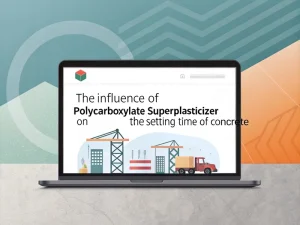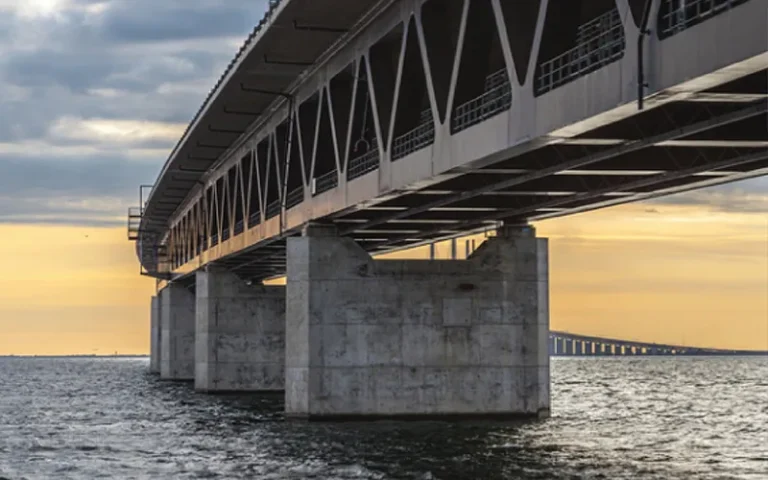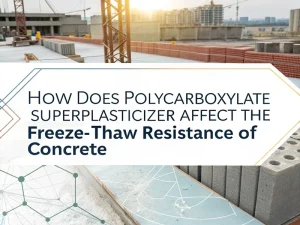
The Influence Of Polycarboxylate Superplasticizer On The Setting Time Of Concrete
Blog The influence of pol
Blog

The marine environment is one of the most corrosive battlefields on Earth for building materials. Salt spray, tides, chemical erosion, and physical erosion are constantly testing the “lifeline” of concrete structures.
Building docks, bridges, seawalls, or offshore wind foundations that can withstand decades of harsh marine environments requires a completely different layer of material – high-performance marine concrete. Behind this technology, a key ‘secret weapon’ plays a decisive role: the Polycarboxylate Superplasticizer for Marine Concrete (PCE) used for marine concrete.
To understand the importance of PCE, it is necessary to first recognise the unique damage mechanism of the marine environment on concrete, which is mainly reflected in the following three aspects:
1. Chloride Attack: This is the number one enemy of marine concrete. Chloride ions in seawater will penetrate through the capillary pores of concrete, reach the surface of steel bars, damage the passive film of steel bars, and cause corrosion. The volume expansion of corroded steel bars ultimately leads to cracking and peeling of the concrete protective layer.
2. Sulphate Attack: Sulphate in seawater reacts chemically with cement hydration products to produce expansive substances (such as ettringite), causing stress inside the concrete, leading to cracking and a decrease in strength.
3. Physical wear and freeze-thaw cycles: Sand and gravel carried by waves and currents will continuously erode and wear the surface of concrete. In cold regions, repeated freeze-thaw cycles can also cause the concrete surface to peel off.
Faced with these challenges, the defence core of marine concrete is only one: to minimise its permeability to the greatest extent possible. In other words, it is to create a dense, almost “water repellent” structure that keeps these harmful ions out.
PCE is a high-performance water-reducing agent, and its unique “comb-like” molecular structure enables it to efficiently disperse cement particles through the steric hindrance effect. The key materials for improving durability from the root, with four core advantages for accurately responding to marine environmental threats:
The corrosion of steel bars induced by chloride ions is the primary cause of failure in marine concrete, and PCE solves this problem through two mechanisms:
Reduce the water-cement ratio: Control the water-cement ratio at 0.35-0.45 (the traditional concrete water-cement ratio is mostly 0.55-0.65), and the concrete porosity can be reduced from 15% to 20% to 5% to 8%. The dense matrix forms a physical barrier, reducing the penetration rate of chloride ions by 60% -70%.
Reduce bleeding and segregation: The polymer molecular chains of PCE can evenly disperse cement particles, eliminate weak and porous areas such as surface slurry (where chloride ions are easily enriched), and avoid the formation of “permeation channels”.
Sulphate in seawater reacts with cement to produce expansive substances such as ettringite and gypsum, which can cause concrete cracking and peeling. PCE improves erosion resistance through the following methods:
Dense matrix anti-permeability: Low porosity reduces the penetration depth of sulphate into the interior of concrete, reducing the probability of reaction occurrence.
Optimise cement hydration: PCE regulates the hydration rate, reduces the content of tricalcium aluminate in cement that is prone to react with sulphates, and reduces the risk of erosion from the source.
For structures such as seawalls and port pavements that come into long-term contact with seawater, this means that their service life has been extended from 15-20 years for traditional concrete to over 50 years (an increase of 3-5 times).
Cold coastal regions such as Northern Europe, Canada, and Alaska require concrete to have excellent freeze-thaw resistance. PCE satisfies this requirement through two points:
Reduce water absorption: The dense matrix reduces the water absorption rate of concrete, and the expansion stress generated during freezing decreases accordingly.
Good compatibility with air entraining agents (AEA): PCE does not interfere with the formation of small stable bubbles by the air entraining agent (which can release the pressure generated by freeze-thaw), while traditional water reducers often disrupt the distribution of bubbles.
Tests have shown that marine concrete mixed with PCE and air entraining agent can withstand more than 1000 freeze-thaw cycles (in accordance with ASTM C666 standard) without significant damage, and its performance is twice that of concrete without PCE.
Marine concrete often needs to meet high workability requirements, such as dense steel reinforcement on offshore platforms, long-distance pumping of port pile foundations, and complex formwork for coastal bridges. PCE provides key construction convenience while ensuring durability:
High fluidity: PCE concrete exhibits a slump expansion of up to 650-800mm (25-31 inches), enabling it to fill narrow gaps, wrap around dense steel bars, and mitigate the risk of segregation.
Extended workability (slump retention): PCE can maintain the good fluidity of concrete for 60-90 minutes (traditional concrete only retains its fluidity for 30 minutes), making it suitable for scenarios with longer transportation and pouring times in offshore engineering.
This advantage avoids adding extra water to improve workability (which increases porosity and reduces durability), achieving a balance between “construction convenience” and “long-term durability”.
Not all PCEs are suitable for harsh marine environments. When choosing, special attention should be paid to the following points:
High slump retention performance: Marine engineering requires PCE to have excellent slump retention ability to ensure long-term workability, given the large pouring volume, long transportation, and pumping times.
Strong adaptability to materials: able to accommodate cement and SCMs from different sources, with stable performance.
Low alkali content helps suppress potential alkali aggregate reactions (AAR), another long-term durability hazard.
Reliable case verification: Prioritise PCE products that have been successfully applied in projects such as large ports and cross-sea bridges.
Even marine concrete mixed with PCE must undergo strict curing to ensure its performance.
In summary, polycarboxylate superplasticizer (PCE) fundamentally solves the two core pain points of marine concrete: permeability and construction quality, by achieving an extremely low water-cement ratio and excellent construction performance.
It is no longer just a simple “water reduction” tool, but an empowering technology for building low-permeability, high-density, homogeneous and defect-free concrete structures. In the protracted battle against seawater erosion, choosing the right PCE is like putting on the strongest ‘armour’ for your ocean engineering, ensuring that it can still stand firm for decades or even centuries to come.

The Influence Of Polycarboxylate Superplasticizer On The Setting Time Of Concrete
Blog The influence of pol

How Does Polycarboxylate Superplasticizer Affect The Freeze-thaw Resistance Of Concrete?
Blog How does polycarboxy